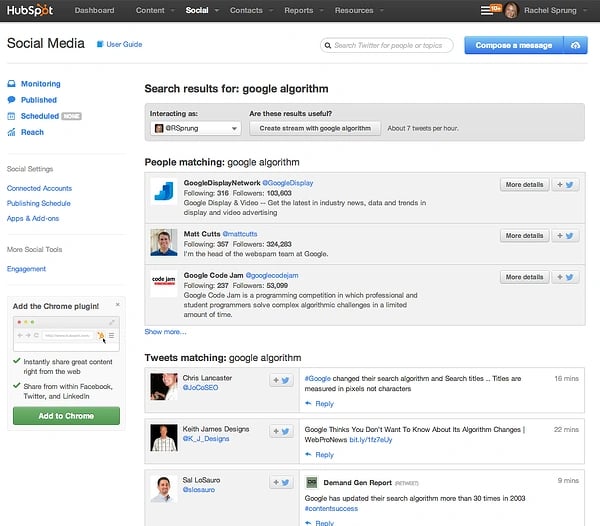Doesn't it seem like every time you turn around there's a new SEO update? You keep hearing about hummingbirds and pandas and penguins, but what the heck does it mean? (And what do these animals have to do with search engine optimization?)

It can be very confusing to stay up to date with everything going on in the world of SEO. It may be even harder if you're not an SEO expert who understands the terminology of these updates. But it isn't impossible.
To stay up to date on SEO trends, there are a few other things you should do to make sure you have the latest SEO information at your fingertips. Here's a process you can follow to remain in-the-know.
1) Create a stream on Twitter.
Twitter's great for fast, real-time news, so to get started, create a stream on Twitter of some terms that are related to SEO. Use terms including "Google algorithm," "Google Panda," "Google Hummingbird," or "Google Penguin." You could choose to use terms like "SEO" and "search engine optimization," but you'll most likely get overwhelmed by the flood of tweets coming in. So I recommend you keep it specific and simple.
In addition to following SEO terms on Twitter, follow thought leaders who are talking about SEO. These may include but are not limited to the following:
HubSpot customers, you can actually do this right in your HubSpot account using Social Inbox -- once you're in the Social Media tool, search for a person or topic at the top. In this case, I'm going to search for "Google Algorithm."

Your search results will appear as shown below. The section at the top will show you people you can follow who are talking about your search term. The tweets at the bottom will show people who have mentioned your search term.

When you're ready to create a stream in Social Inbox based on your results, click "Create stream with google algorithm" ... or whatever your search term is ... at the top. Note that you will also be able to see how many tweets you should expect per hour.

2) Subscribe to SEO blogs.
Whenever there is a major SEO change, SEO blogs light up with informational content that helps the rest of the world make sense of it all. Set up your RSS feed -- or subscribe via email -- to make sure you don't miss anything. You may see some articles that delve too much in the nitty gritty for your taste, but that's alright -- ignore those, and just focus on the posts that let you know about new trends and recent updates that impact how you do your job.
If you want to take this a step further, set up a Google Alert for some of the same SEO terms that you used to create your Twitter stream. This will ensure that you find out either immediately, daily, or weekly, depending on your preferences.
Here are a few fantastic SEO blogs that you can use to start off your RSS feed or email subscriptions:
3) Stay up to date with Google Webmaster Tools.
Google Webmaster Tools aren't just a way for people to make sure their sites are properly optimized. Yes, it does that, but it also has a series of resources that explain SEO best practices to you. You can find out information about SEO, how Google crawls your site, and much more.

Google Webmaster Tools can also provide detailed information about your site's performance, including your search queries, internal links, keywords you rank for, and more. For more details about everything you can do with these tools, check out this post.
4) Put 15-30 minutes aside each week to learn.
If you really want to stay in the "know" about everything SEO, it's important to put some time aside to actively consume the information. If you have more than 15-30 minutes a week to do so, that's great, but a weekly check-in should help you stay relatively current.
If you want to do deeper dives, you probably need to budget more time for yourself. Either way, block off some time on your calendar to make sure you put the resources you've gathered to good use.
5) Use HubSpot's SEO panel.
If you're a HubSpot customer using the COS blog, you may have seen a recent addition to your blogging tool -- the SEO panel -- which gives you actionable advice on how to optimize your blog content. The beauty of this panel is that as SEO updates are made, the SEO panel will be updated to reflect the most up-to-date information about how to optimize your content for SEO.
Think of it this way: All of the information you learn about SEO and the newest trends is built into the panel to help you stay up to date every single day. You'll see a list of actionable tips, linking recommendations, even call-to-action suggestions to help improve your conversion rate.

6) Join SEO-focused LinkedIn Groups.
Whenever I want to see intelligent discussions about topics that impact my day-to-day job or my career, I turn to LinkedIn Groups. There are tons of resources, articles, and discussions for anyone looking for help with SEO, so you can be sure you'll hear about big updates there. Even better, you'll have the opportunity to ask questions and engage with other people who are interested in the updates and know a lot about SEO.
Personally, I recommend these LinkedIn Groups -- but go ahead and explore others that you may be interested in joining:
Alright, your turn -- what other ways do you stay up to date on SEO trends? What's your go-to resource?



![8 SEO Challenges Brands Face in 2023 [HubSpot Blog Data]](https://blog.hubspot.com/hubfs/seo challenges_featured.png)
![Should Marketers Optimize for Bing? [Data + Expert Tips]](https://blog.hubspot.com/hubfs/BING-SEO (1).png)





